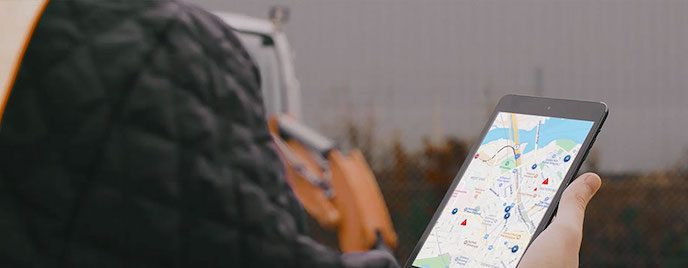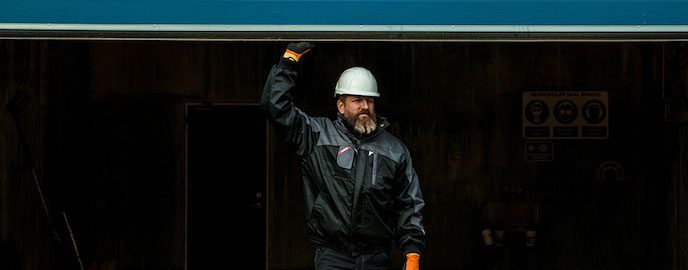

At a recent interview, an industry journalist asked what predictions I had for the construction industry in the forthcoming year. It was a slightly difficult question for me to answer for a couple of reasons: Firstly, our industry seems to have its own time laws – 12 months in construction feels like a quarter in any other, a blink of an eye. Secondly, we are being impacted by macro and micro trends which are gradually having an effect on our ways of working.
Since Trackunit CEO, Jørgen Raguse answered a similar predictions question by looking back at the last decade, I’m going to look forward to the next ten years in this post. I’ve curated some of the things which intrigue me, however, it’s not a comprehensive list! If you think there’s something important which I’m missing, please leave a comment or contact me directly via the website or LinkedIn.

The writer and thinker, Azeem Azhar calls this a dominant narrative for the foreseeable future. The observable costs of climate change – both environmental and financial – has suddenly shifted the conversation on in record time on all kinds of fronts during 2019. Reporting on everything from environmental catastrophes such as the fires in South Australia to the UN policy on Climate Change and the efforts of activists like Greta Thunberg are doing much to keep this emotive subject in the public eye. Despite their critics, the existence of certification schemes such as LEED and BREEAM demonstrates there is concern about sustainability and carbon impact in the construction industry. We may be moving, but more could always be done. For example, right now I believe we need to move quickly to establish standards to connect efficiency with CO2 emissions. Although electrification seems an easy win, as we move forward, we need to ensure that the tools and equipment that are vital to productivity, are powered or fueled in the most appropriate way so that tasks can be performed in the optimal manner. That could mean some trade-offs when it comes to greening operations, we could for example need to continue using conventional engines for some operations. However, it is important that the industry itself demonstrates the predisposition to act responsibly before external forces start imposing regulatory frameworks.

Nothing will propel next generation technologies such as autonomous vehicles, AR and VR like 5G. The deployment of 5G, will allow for ubiquitous, low-cost communications for everyone, everywhere. It will also provide the tipping point for the widespread roll-out of the Internet of Things (IoT) in all probability, as cheap and ubiquitous sensors and processors are joined by high bandwidth, low latency, affordable global connectivity to drive a revolution in tech. We should not underestimate the momentum which 5G will carry as it delivers the connected construction site. In our business, manufacturers including Volvo Construction Equipment (and Trackunit) have been very quick to announce and demonstrate their commitment to the technology. For a sector that has been accused of being a laggard when it comes to digitalisation, the adoption of 5G is set to bring a host of productivity, efficiency and safety benefits to the jobsite as companies avail themselves of connected equipment, wearable tech, hardware advancements, AR/ VR, drones, and autonomous machines.

Right now I’m excited by the concept of the learning organisation, developed by Peter Senge in his book “The Fifth Discipline.” It’s becoming clear that what current generation leaders learned at business school towards the end of the last century (!) may not help organisations to compete in the new 20’s. So much so that Microsoft recently cited the new frontier in competitiveness is an organisation’s ability to learn. By shifting to more interconnected ways of thinking, improving communication, building trust and community, companies can find competitive advantage in today’s marketplace. Satya Nadella, CEO at Microsoft says that to build tech-enabled learning companies, end-to-end digital feedback loops need to be created, taking data from one system to optimize another. Putting AI first enables the rise of workplace analytics and mindset shift from “know everything” to “learn everything.” It can also help to solve the challenge of continuing to innovate as a corporation grows. However, change is hard, as any company that has undergone any form of migration will know. Adaptation will be vital for companies to survive and thrive in the coming years.

Generations of digital natives are moving into influential positions in all businesses and will be taking control during the next decade. People who find change hard will find that culture has shifted as younger people come into organisations with their ideas about diversity, equality, and ways of working. However, this has the potential to create challenges when recruiting. The author Geoffrey Moore, for example, says hiring for diversity is easier said than done. A tendency to hire the best fit for the job, or the best fit for the company culture means we end up with new people too similar to those already in place; “homogeneity quietly suppresses heterogeneity,” he says. As a foil to this, Moore quotes Sallie Krawcheck, head of Ellevest, who offers two pieces of advice: Instead of asking, is this person the best fit for our culture, ask, is this person the best add to our culture. Instead of asking, is this person the best one for the job, ask, is this person the best one for the team. The way that businesses adapt to generational change, indeed any change, (see above) is also going to impact short and long-term prospects. I say that because unless corporations can engender an enabling culture which is attractive to tomorrow’s bright young things, talent acquisition will be stymied and with that, next generation everything.

The indications are that the industry is already receptive to advancements that can be made in the design, planning and delivery of construction projects using AI. The technology clearly has the capability to enable safer and more efficient site working, with better provision and operation of tools and machines. But there’s much greater scope; the technologist Ray Kurzweil predicted that by 2030, AI will reach human levels of performance, meaning that anyone with an internet connection will be able to “supplement their cognitive ability, augment their problem-solving capacity, and build new ventures at a fraction of the current cost.” This trend will be driven by the convergence of global high-bandwidth connectivity (see above), neural networks, and cloud computing. as we’ve already seen, some sacred cows need to be put to rest for the industry to kick the habit of doing things the way they have always been done.

We’ve written about data as the new oil, and then afterwards about data as not the new oil. But I’m beginning to see data as a kind of yeast that permeates almost everything we do in the modern world, and increasingly key to enlightened decision-making about products, services, employees, strategy and more. Business seems to have been talking about data as an asset for at least a decade, yet in some quarters it still seems hesitant to prioritise collection and analysis. Hesitation which is perhaps brought on by information overload or paralysis caused by the volume of the task (what data should we collect, why should we collect it and how should we analyse it). Many are simply waiting until they can deliver a transparent, future-proof business model which also demonstrates a financial return to the business. To those that are in a holding pattern for whatever reason, I would say, just collect the data. All of it. Because if you don’t, someone else will and that could be commercially harmful to your company’s prospects.

For now, as a result of all kinds of geopolitical reasons, it looks as though the world is sailing into an economic headwind; a slowing but not a recession. Whatever happens – and that can change quickly – the construction world will continue to meet the need for buildings to accommodate population growth and business requirements, together with the infrastructure to support both. As an industry, we’ll need to do this sustainably and profitably. At Trackunit, we foresee a need for construction to get serious about implementing technology and move on from a garage mentality building prototypes and models. Slowdowns create pressure for companies to find new ways of working, technology is provenly one way of delivering change – look at how process automation and robotics have increased manufacturing productivity and quality.

I can’t not mention Eliminate Downtime. If the movement continues on its current trajectory towards its goal, we can collectively succeed in eliminating downtime in all its forms from the construction industry. Already the movement has caught the imagination of construction equipment manufacturers and third-party developers with the creation of new collaborative partnerships and alliances to solve industry challenges. There has a been a marked uptick in the dialogue around technology’s capacity to help increase the efficiency of construction tasks. As the movement has attracted an industry-wide audience, it has been joined and is now being led by an inclusive and cross-disciplined committee which reads like a “who’s who” of the business. Last month, the Eliminate Downtime community met up in Copenhagen to discuss, amongst other topics, how AI can be put to use to help bring positive change to construction.
…what current generation leaders learned at business school towards the end of the last century (!) may not help organisations to compete in the new 20’s
For an industry which has been around since humankind moved out of caves to build homes, the rate of change today excites me. From the innovative ways that buildings are being designed, the materials being utilised and the approaches which are being taken to construction, it’s fascinating to see technology increasingly being part of the landscape. It will also be an enabler for future ways of working together, driving forward corporate culture, augmenting teams and individuals as they propel innovation in currently unimaginable directions.
Let me know what’s got your attention in 2020 – leave me a message!
Never miss an insight. We’ll email you when new articles are published on this topic.

